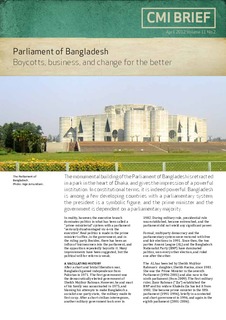| dc.contributor.author | Amundsen, Inge | |
| dc.date.accessioned | 2018-01-04T08:18:45Z | |
| dc.date.available | 2018-01-04T08:18:45Z | |
| dc.date.issued | 2012-04-11 | |
| dc.identifier | oai:www.cmi.no:4423 | |
| dc.identifier.citation | Bergen: Chr. Michelsen Institute (CMI Brief vol. 11 no. 2) 4 p. | |
| dc.identifier.issn | 0809-6732 | |
| dc.identifier.uri | http://hdl.handle.net/11250/2474907 | |
| dc.description.abstract | The monumental building of the Parliament of Bangladesh is retracted in a park in the heart of Dhaka, and gives the impression of a powerful institution. In constitutional terms, it is indeed powerful. Bangladesh is among a few developing countries with a parliamentary system; the president is a symbolic figure, and the prime minister and the government is dependent on a parliamentary majority. In reality, however, the executive branch dominates politics in what has been called a “prime-ministerial” system with a parliament “seriously disadvantaged vis-à-vis the executive”. Real politics is made in the prime minister’s office, in the government, and in the ruling party.
For the full report, see the project page
Bangladesh programme page | |
| dc.language.iso | eng | |
| dc.publisher | Chr. Michelsen Institute | |
| dc.relation | CMI Brief | |
| dc.relation | 2 | |
| dc.relation.ispartof | CMI Brief | |
| dc.relation.ispartofseries | CMI Brief vol. 11 no. 2 | |
| dc.relation.uri | https://www.cmi.no/publications/4423-parliament-of-bangladesh-boycotts-business | |
| dc.subject | Bangladesh | |
| dc.title | Parliament of Bangladesh: Boycotts, business, and change for the better | |
| dc.type | Report | |
